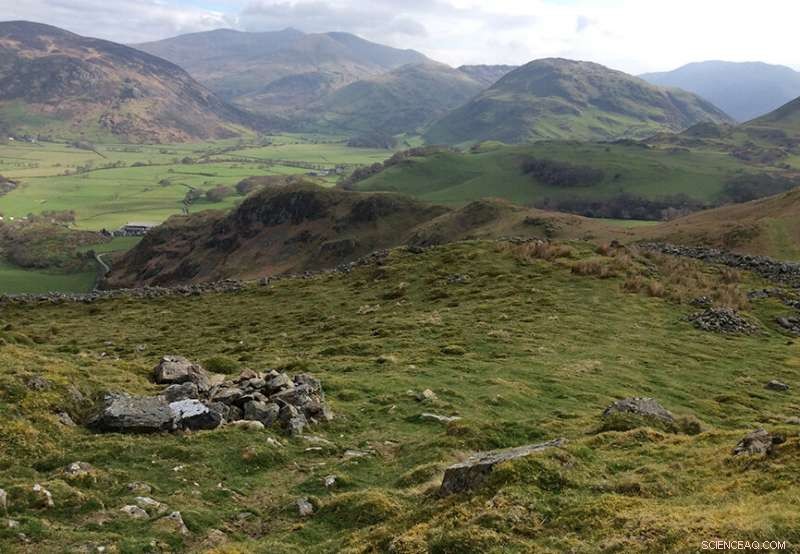
Dysynni-dalen i Wales som är hem för rester av postmedeltida jordbruksverksamhet som inkluderar drystone-väggar. Torrstensmurar är ett nyckelelement i den historiska karaktären av landskapet i Dysynnidalen, men också över resten av Snowdonia, sjödistriktet, och Peak District. Ändrade väderförhållanden, som varmare temperaturer och längre växtsäsonger, innebär att vegetationstypen i detta område kan förändras, buskar eller träd kan växa över resterna, dölja dem och ändra landskapets historiska karaktär. Kredit:University of Sheffield
Några av Storbritanniens mest älskade historiska landskap som Lake District, Snowdonia och Orkneyöarna riskerar att bli allvarligt skadade och förändrade för alltid av effekterna av klimatförändringar, enligt en arkeolog från University of Sheffield.
Forskning av Isabel Cook, en Ph.D. student från universitetets arkeologiska institution, lägger till de växande bevisen för att historiska landskap över hela Storbritannien redan har påverkats av klimatpåverkan, såsom havsnivåhöjning, kusterosion och översvämningar.
Bland de historiska landskapen som påverkas är Dysynni Valley i Wales, som är hem för militära kvarlevor som går tillbaka till andra världskriget. Isabels forskning har funnit att området är utsatt för havsnivåhöjningar och översvämningar, med lämningarna under allvarligt hot om erosion.
Tidigare studier har visat att historiska platser som Forts of the Saxon Shore, en samling romerska kustfästningar som sträcker sig längs Englands sydöstra kust och inkluderar funktioner på Dover Castle, Pevensey Castle och Burgh Castle, har påverkats i varierande grad av kustprocesser som erosion och jordskred. Några av Saxon Shore Forts har förlorats helt på grund av erosion, som de på Walton Castle i Suffolk.
Den lilla staden Dunwich, som var ett stort centrum för medeltida skeppsbyggnad och handel på Suffolks kust på 1300-talet, har sett sin kustlinje dra sig tillbaka med 600 meter – något som helt har förstört stadens kulturarv och historiska karaktär. Tio kyrkor och en prästgård har gått förlorade där hittills, med erosion som fortsätter att hota resten av området.
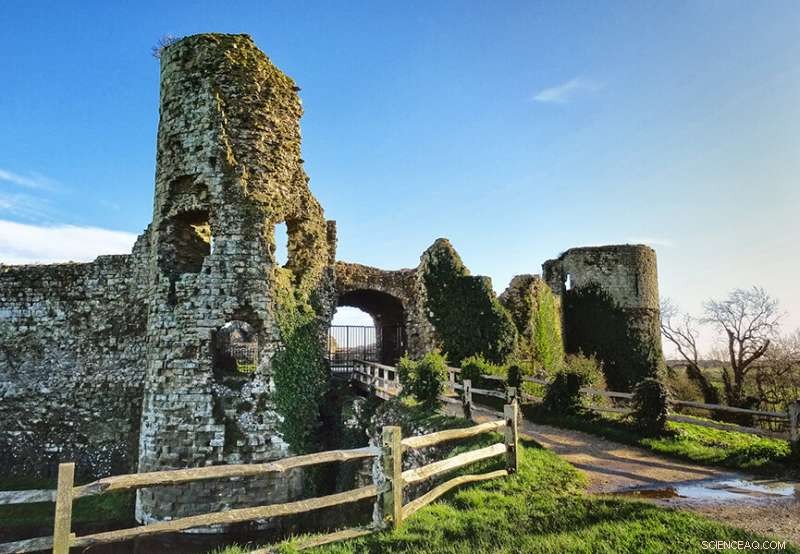
Pevensey Castle har funktioner som är en del av Forts of the Saxon Shore - en samling romerska kustfästningar som har påverkats i varierande grad av kustprocesser som erosion och jordskred. Kredit:University of Sheffield
Isabels forskning avslöjar hur förlusten i Dunwich inte bara relaterar till försvinnandet av enskilda byggnader och platser isolerat, men också till förlusten av stadens arv och stadslandskapets historiska karaktär.
Med hotet mot Dysynni Valley, förlusterna på Sydostkusten och de senaste nyheterna att stigande hav och ökad nederbörd hotar världsarvsstatusen på Orknöarna, University of Sheffield arkeolog efterlyser nu mer åtgärder för att skydda Storbritanniens historiska landskap, som hon betonar är "levande museer".
Isabel sa:"Landskap är oerhört viktiga för kulturarvet, inte bara i Storbritannien utan i alla länder runt om i världen. De är dynamiska utrymmen som håller nationens arv och historia samtidigt som de fungerar som turistattraktioner och stödjer jordbruksindustrin. De är platser som vi interagerar med, och bor inom, bildar sammanhanget i våra liv, försörjning och minnen. Detta gör landskap extremt viktiga för kulturell identitet, så vi måste vara medvetna om det mycket verkliga hotet de står inför från effekterna av klimatförändringar.
"Åtgärder vidtas redan för att försöka skydda viktiga historiska monument, men vi måste inse att betydande landskap också är utsatta för klimatförändringar.
"Föreställ dig ett Storbritannien där de historiska gatorna och promenaderna i viktorianska kuststäder som Brighton, Bournemouth och Aberystwyth döljs av hårda kustförsvar byggda för att skydda hem och företag från erosion, stigande havsnivåer och extrema översvämningar. Imagine a UK where the ornamental gardens of historic estates, like Chatsworth in Derbyshire and Cragside in Northumberland, are blighted by new invasive species, pests, and diseases, and ravaged by drought. We need to ensure our grandchildren and their grandchildren can experience and learn from these places as we have done."
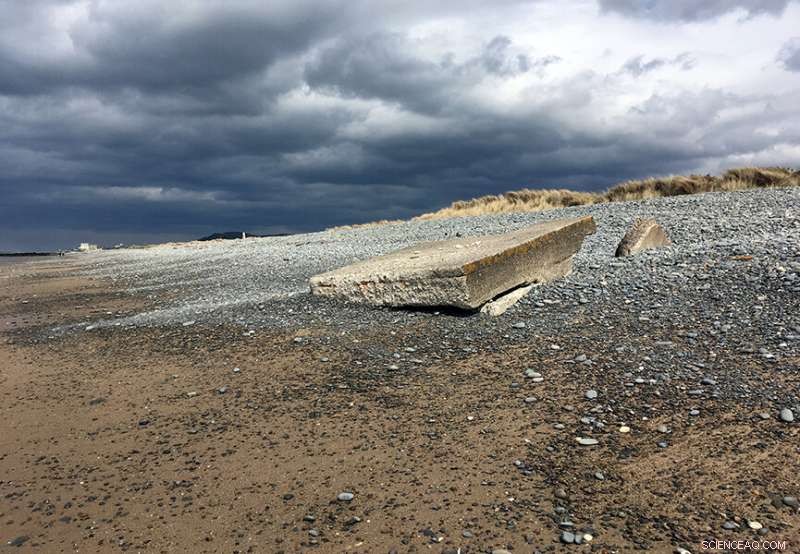
A collapsed WWII pillbox on Aberdyfi beach. This area has an important connection with Britain's military history, with an RAF base located here until 1945, when it turned into an army base. There are also nearby shooting ranges, and several known aircraft crash sites in the surrounding hills. Increasing storminess and coastal erosion will accelerate the demise of these features which connect the area to an important part of history that is still within living memory. Credit:University of Sheffield
While heritage agencies are beginning to acknowledge and take steps towards addressing the threat posed by climate change to historic buildings, monuments and sites, research by the University of Sheffield archaeologist reveals how little is being done to protect the landscape itself.
English Heritage has published a risk assessment on the threat of coastal erosion to its estate and the Shifting Shores report looks at the potential impact of climate change on National Trust properties. Although these reports mention the landscape setting of heritage sites, Isabel's research highlights how they do not specifically mention the threat to the historic landscape.
Research by the Sheffield Ph.D. student also reveals how most previous academic studies into the impact of climate change on archaeological remains omit any mention of historic landscapes.
Som svar, Isabel has developed a framework for including historic landscapes in climate change impact, adaptation and mitigation research. This includes assessing how vulnerable historic landscapes are to the effects of climate change.
The framework also establishes a sustainability assessment methodology for coastal and flood-risk management that includes historic landscapes as a consideration—something which could be used by policy-makers to include the historic character of the landscape in climate change adaptation decisions. This could change the way that coastal erosion and flood-risk management is carried out in the future, with more consideration of the historic landscape alongside environmental, social and economic factors.
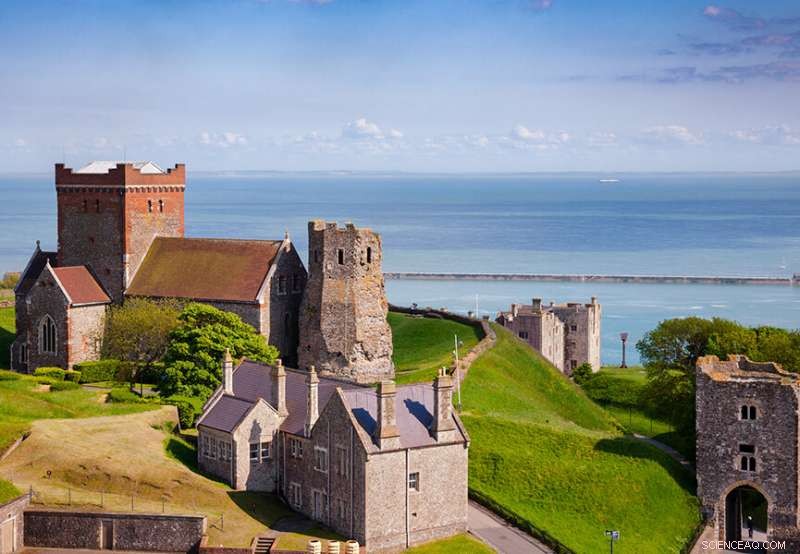
Roman lighthouse and St Mary de Castro church at Dover Castle. The castle also includes features that are part of the Forts of the Saxon Shore. Credit:University of Sheffield
The Sheffield Ph.D. student's research also highlights how changes in temperatures and rainfall caused by climate change are likely to affect the distribution and behavior of plants and animals on important historical landscapes. Examples include the expansion of insect species towards higher latitudes and increased over-winter survival, which poses a greater risk of insect attack or bioturbation on important archaeological landscapes and remains.
Changing climatic conditions may also lengthen crop growing seasons and force people to grow food in different places, such as areas of important historical and cultural interest. Till exempel, arable crop farming may become an option in areas once only suitable for extensive sheep farming. As well as affecting local economies and traditional ways of life, this change could affect the visual character of historically important landscapes, according to the study.
Historic woodland, parks and gardens, which characterize many historic landscapes, are also likely to be affected by changing temperatures and invasive species. This may affect the plants that can be grown in parks and gardens, and alter the ecosystems structure of ancient woodlands.
Dessutom, the University of Sheffield study highlights how the impact of climate change on historic landscapes is not limited to direct impacts—there may be impacts caused by the mitigation and adaptive approaches that are taken in response to climate change. Till exempel, the construction of coastal defenses in response to rising sea levels could result in a coastal squeeze, causing the loss of saltmarsh and beach.
Coastal defenses can also significantly alter the character of the coastline, affecting visual amenity. The Sheffield archaeologist is calling for the impact of coastal defenses on the historic landscape as a whole to be considered, rather than just the impact on individual archaeological sites.
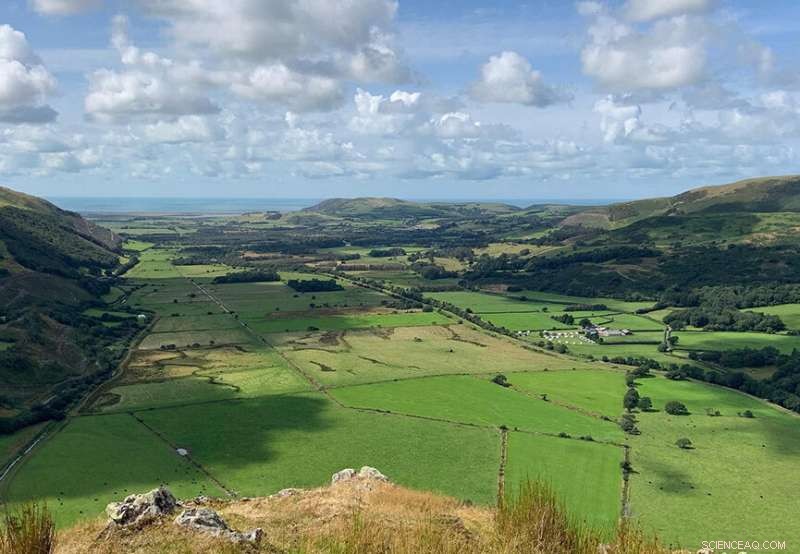
Birds Rock in the middle of the Dysynni Valley. Isabel's research indicates that, under a medium-emission scenario, all of the low-lying land pictured here would be under the mean high tide mark. This means that most of it would become unsuitable for any agricultural uses, and it may turn into wetland. This would be vary detrimental to the local economy, which is heavily reliant on the pastoral agriculture industry. Credit:University of Sheffield
Isabel added:"A great wealth of archaeological material can be found on the British coastline and is now vulnerable to changing coastal processes that are being triggered by climate change.
"We've already seen coastal erosion and landslides—which are projected to worsen due to sea-level rise and increasing storminess—destroy many historic and prehistoric coastal fortifications and settlements on the south east coast of England. The loss of these features threatens the historic character of these coastal landscapes, be it a military and defensive landscape, a religious and early Christian landscape, or a landscape characterized by post-medieval trade and industry. We need to ensure that the historic landscape is factored into all climate change impact and adaptation research and management in the UK, at all stages of policy development and planning, rather than being considered only by heritage agencies.
"The framework developed through my research provides a simple method for establishing the different ways in which the character of each historic landscape is vulnerable to climate change. It also gives planners and policy-makers a useful tool for assessing the various ways in which different coastal and flood-risk management approaches will impact the historic landscape."